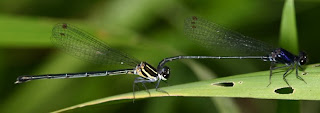There are three
Brachydiplax species in Peninsular Malaysia namely
B. chalybea,
B. farinosa and
B. sobrina. Three of them look alike, particularly between
B. farinosa and
B. sobrina. In this entry I am showing
B. chalybea. By far,
B. chalybea is the most easy to encounter among the three.
Brachydiplax chalybea are readily to be distinguished by its yellow tint at the base of the wings and its thorax is more brownish compared to the other two species. The female
B. chalybea is more brownish compared to the male.
 a male B. chalybea
a male B. chalybea a female B. chalybea
a female B. chalybea










































